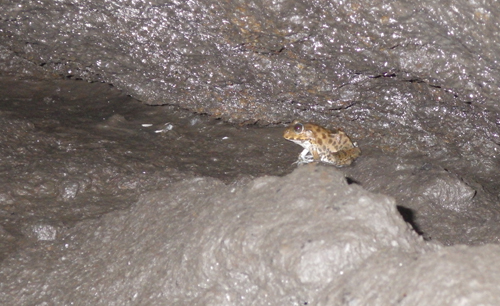
With a record length of three caves in the lava cave system recently discovered in Dak Nong Province, Vietnam has five longest lava caves in Southeast Asia. Previously, Hang Doi 1 and 2 (Bat Caves) in Dong Nai held the top spots.
With a record length of three caves in the lava cave system recently discovered in Dak Nong Province, Vietnam has five longest lava caves in Southeast Asia. Previously, Hang Doi 1 and 2 (Bat Caves) in Dong Nai held the top spots.
 |
| The location of K'luk Chu crater and the caves B1 to B3 and C1 to C7 on a satellite photo. |
A 25 km volcanic cave system was discovered in Krong No district, in the highlands province of Dak Nong. The information was announced at a press briefing held in Hanoi on December 26 by General Department of Geology and Minerals of Vietnam (GDGM) and the Japan Caving Association (JCA).
Since 2007, with the support of UNESCO, GDGM has implemented the project "Study of geological heritage to build the geological park and protect the environment of the area of Trinh Nu Waterfall, in Cu Jut District, Dak Nong Province, Central Highlands of Vietnam". During the survey, scientists discovered volcanic caves in basalt in Chu B'Luck, in Buon Choah commune, Krong No district.
The cave system discovered in the forest had several living animal species but no traces of human habitation. The scientists have conducted detailed measurements of three of the 12 caves, including a 1,066.5 meter volcanic cave which has been evaluated as the longest volcanic cave in Southeast Asia.
Inside the cave, distinguished structural characteristics include lava banks, lava flows, sinkholes, relics of plants and the hardening of basalt lava from millions of years ago.
The findings attracted special attention of scientists at home and abroad, including the JCA. Dr. Hiroshi Tachihara, Honorary President of this Association and his successor, Dr. Tsutomu Honda, came to Vietnam to jointly research, survey and evaluate the cave system in Dak Nong.
"This finding surprised us because originally we did not think that Vietnam had volcanic activity," said Dr. Hiroshi Tachihara.
Planning for an adventure was launched because according to Japanese scientists, this volcanic cave system is much more beautiful than those in Japan and South Korea. However, a research group of JCA and the Geological Museum of Vietnam, with the help of Dak Nong authorities, began studying this volcanic cave system since 2012.
 |
| Traces of lava flows remain in cave C7. |
"The low-viscosity lava from K'luk Chu crater has formed a basalt plateau. In particular, the basaltic lava flows in the Dray Sap waterfall region have created a tubular cave and this is the longest basalt cave in Southeast Asia," said Dr. Tsutomu Honda, adding that the findings has the great value for tourism.
In the system consisting of dozens of caves, scientists thoroughly studied three caves denoted C7, C3, and A1. C7 is a volcanic tube cave with a length of over one kilometer and is the largest lava cave in Southeast Asia.
To reach cave C7, Mr. Tsutomu Honda said scientists had to hang up on the rope from top to get into the cave. Scientists were surprised to see so many traces of trees and lava inside. Besides, there are many structures characterizing the process of lava eruption of millions of years ago. "The floor of C7 cave is very beautiful, with many patterns and looks like the surface of a lava flow. There are many stalactites and different branches in the cave," said Dr. Tsutomu Honda.
Then, the group survey C3 cave with the length of 594.4 meters. As described by Mr. Tsutomu Honda, this is a tube-shaped cave, with very smooth lava flows. On the cave walls are many monuments, especially moulds of plant fossil, suggesting the presence of a forest at the time of volcanic eruptions.
A1 cave is 456.7 meters long with the lava flows inside the cave bulging and scientists compare it as a dike.
With this result, according to Mr. Tsutomu, Vietnam holds five records of lava caves in Southeast Asia. In particular, the C7 is the longest tube-shaped lava cave in Southeast Asia; C3 holds second place; and A1 takes the fifth position. The 3rd and 4th belong to Hang Doi 1 and 2 (545 m long) in Dong Nai. The Gua Lawah cave in Indonesia is ranked 6th with a length of 400 m.
 |
| A frog species discovered in the C7 cave. |
The research team began its survey in cave groups B and C (C1, C2, C4, C5, C6, C8) on Dec. 27.
To promote the site’s potential, the Dak Nong provincial People’s Committee has asked the province’s Department of Culture, Sports and Tourism to work with the Vietnam Museum of Geology to carry out a project to study and evaluate the geological heritage.
The committee plans to make the geological park a national heritage site and has suggested to UNESCO that it wants recognition as a global geological park. The cave system will also be added to the province’s master plan of tourism development in the 2011-2015 period, and towards 2020.
(Source: VNN)




